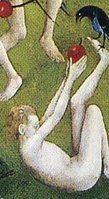(12) Juana or Mencía de Mendoza

 The question of whether some panels seen in the palace of Hendrick III of Nassau in 1517 were from The Garden of Delights/El Jardín de las Delicias is now moot, since x-rays make it clear that the Nahuatl chronology showing the years 1519 through 1528 was part of the original composition, not something added later. Prior to some correspondence relative to the tapestries there is no record of the its existence. (See Paul Vandenbroeck, High Stakes in Brussels, 1567: "The Garden of Earthly Delights as the Crux of the Conflict Between William the Silent and the Duke of Alva," in Hieronymus Bosch: New Insights Into His Life and Work, Rotterdam, 2001, pp. 87-90.) In 1567 the triptych was apparently confiscated from Hendrick III's nephew William the Silent, and it is usually assumed that the original owner was Hendrick III, based only on the 1517 report about some other panels.
The question of whether some panels seen in the palace of Hendrick III of Nassau in 1517 were from The Garden of Delights/El Jardín de las Delicias is now moot, since x-rays make it clear that the Nahuatl chronology showing the years 1519 through 1528 was part of the original composition, not something added later. Prior to some correspondence relative to the tapestries there is no record of the its existence. (See Paul Vandenbroeck, High Stakes in Brussels, 1567: "The Garden of Earthly Delights as the Crux of the Conflict Between William the Silent and the Duke of Alva," in Hieronymus Bosch: New Insights Into His Life and Work, Rotterdam, 2001, pp. 87-90.) In 1567 the triptych was apparently confiscated from Hendrick III's nephew William the Silent, and it is usually assumed that the original owner was Hendrick III, based only on the 1517 report about some other panels.An alternative explanation for the triptych's presence in Brussels could be that Mencía de Mendoza, the wife of Hendrick III, took it there, or that it was sent to her. It might conceivably have been painted for her rather than for Juana, since in the Nahuatl chronology the year 1524 is in the Eden scene; in other words it might mark both the arrival of the Franciscans in New Spain and Mencía's marriage in 1524.
The drawing of Mencía Mendoza showing her loading a boat while wearing a fancy dress is from the same album as the well known ones of Cortés and of some Indians who went to Spain with him in 1528, who possibly also appear in the triptych. (See Christoph Weiditz, Authentic Everyday Dress of the Renaissance: All 154 Plates from the "Trachtenbuch," Dover, 1994.)





